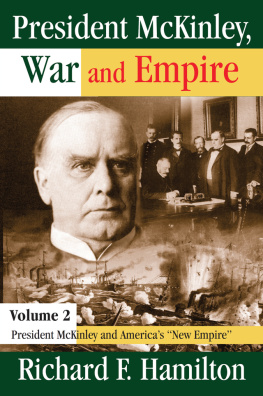Americas New Empire
Americas New Empire
The 1890s and Beyond
Richard F. Hamilton
First published 2010 by Transaction Publishers
Published 2017 by Routledge
2 Park Square, Milton Park, Abingdon, Oxon OX14 4RN
711 Third Avenue, New York, NY 10017, USA
Routledge is an imprint of the Taylor & Francis Group, an informa business
Copyright 2010 by Taylor & Francis.
All rights reserved. No part of this book may be reprinted or reproduced or utilised in any form or by any electronic, mechanical, or other means, now known or hereafter invented, including photocopying and recording, or in any information storage or retrieval system, without permission in writing from the publishers.
Notice:
Product or corporate names may be trademarks or registered trademarks, and are used only for identification and explanation without intent to infringe.
Library of Congress Catalog Number: 2010004001
Library of Congress Cataloging-in-Publication Data
Hamilton, Richard F.
Americas new empire : the 1890s and beyond / Richard F. Hamilton.
p. cm.
Includes bibliographical references and index. ISBN 978-1-4128-1320-4 (alk. paper)
1. United States--Foreign relations--1865-1898. 2. United States --Foreign relations--1897-1901. 3. United States--Foreign relations--20th century. 4. United States--Territorial expansion. 5. Progressivism (United States politics)--History. 6. Imperialism--History. I. Title.
E661.7.H36 2010
973.8--dc22
2010004001
ISBN 13: 978-1-4128-1320-4 (hbk)
Contents
Acknowledgments
This work, like my six previous books, has been supported by the Mershon Center at the Ohio State University. As before, I wish to thank Richard Herrmann, the Centers director, and Mershons superb staff, most especially Beth Russell, for their generous support and assistance.
Many people have helped in the production of this book, reading drafts, providing comments and suggestions, and indicating matters in need of correction. It would be difficult to allocate precise credits, hence this easy solution, a list of the contributors. I offer my great appreciation and thanks to the following friends, co-workers, and acquaintancesRobert W. Cherny, John Milton Cooper Jr., G. William Domhoff, Hal Durian, William Form, John F. Guilmartin, Holger Herwig, Brian M. Linn, Gary Marotta, Frederick Milford, John Mueller, Paul W. Schroeder, Douglas Southgate, and David Trask. I wish to commend others who helped with this projectPatricia Lai, Hawaii State Archives, Honolulu; Deidra Herring, David Lincove, and Mary Ries of the Ohio State Library, and Janet Metzger of the McKinley Presidential Library and Museum, Canton, Ohio.
As always, the many contributions of Irene Hamilton are gratefully acknowledged.
A special debt is owed to Henry Ashby Turner, a friend and co-worker for more than three decades. Approximately five inches of letters in my files attest to his generous assistance over those years. Regrettably, Henry is no longer with us. It is a great loss, he is very much missed.
Richard F. Hamilton
12 July 2009
Frequently Cited Works
This book is a follow-up to my two previous worksPresident McKinley and the Coming of the War, 1898 (New Brunswick, NJ, 2006) and President McKinley and Americas New Empire (New Brunswick, NJ, 2007). In the notes to the following chapters, they will be abbreviated, respectively, as Hamilton, Coming of the War, and Hamilton, Americas New Empire.
Four best-selling American history textbooks were used in those works, this as reported in History: U.S. Survey: 1865 to Present for the academic year 2001. The statement was provided by the Monument Information Resource, College Textbook National Market Report. This volume continues using those four works but, understandably, with the most recent editions. These are:
Robert A. Divine, T.H. Breen, George M. Fredrickson, R. Hal Williams, Ariela J. Gross, H.W. Brands, America Past and Present (8th edition, New York, 2007), Vol. 2.
James A. Henretta, David Brody, Lynn Dumenil, Americas History (6th edition, Boston, 2008), Vol. 2.
Gary B. Nash, Julie Roy Jeffrey, John R. Howe, Peter J. Frederick, Allen F. Davis, Allan M. Winkler, Charlene Mires, Carla Gardina Pestana, The American People (7th edition, New York, 2007), Vol. 2.
Mary Beth Norton, Carol Sheriff, David M. Katzman, David W. Blight, Howard P. Chudacoff, Fredrik Logevall, Beth Bailey, A People and a Nation (8th edition, Boston, 2008).
These will be abbreviated throughout as Devine et al., Henretta et al., and so forth.
Much use will also be made of John A. Garraty and Mark C. Carnes, eds., American National Biography (New York, 1999). Entries will be abbreviated as in the following exampleAstor, John J., ANB, 1:696-699.
Maps and Table
1
Imperialism in the Progressive Framework
This work reviews and assesses arguments made about American outreach in the 1890s. The specific concerns are: the Spanish-American War, 1898-1899, some antecedents, and the settlement that yielded an overseas empire. The work addresses the claims put forth in the progressive tradition, the dominant tendency in American history. Those accounts tell of the persistent efforts of outreach, the many attempts by the United States, its leaders and masses, to acquire, rule, and exploit new territories, most of them on the North American continent. But in the late 1890s, the pattern changed. Hawaii was annexed in July 1898 followed by, in February 1899, the acquisition of Puerto Rico, the Philippines, and two other Pacific islands, Guam and Wake. One historian described the development as the great aberration. But other historians have emphasized continuity, portraying the new development as a culmination of previous tendencies. As summarized in many accounts, the United States had become a world power.
The progressive accounts are based on three fundamental assumptions. The first holds that the nation is ruled through a chain of command directed by the leaders of big business, the wealthy bankers and industrialists. Political leaders, the elected and appointed officials figure prominently in those accounts but they are assigned less importance, being treated typically as little more than agents of the business leaders. The best example would be President William McKinley who, for much of the twentieth century, was depicted as a pliable conformist, as the tool of Mark Hanna, a rich and powerful businessman.
The second assumption is that the basic aim of the dominant business leaders wasand remainsprofit this based on exploitation of the people. Some serious difficulties, however, threatened their profit-seeking efforts in the 1890s. The glut of goods produced by the nations factories and farms, it is claimed, could not be sold in the saturated domestic markets, a problem that led to a major depression in 1893. For business leaders then, the driving concern was to acquire new outlets for the surplus goods that could not be sold in the home markets. The need was urgent since without those new outlets the nation faced continuing economic difficulties, rising unemployment, the growth of radical movements, and the threat of political insurgency. New overseas markets, allegedly, would provide








